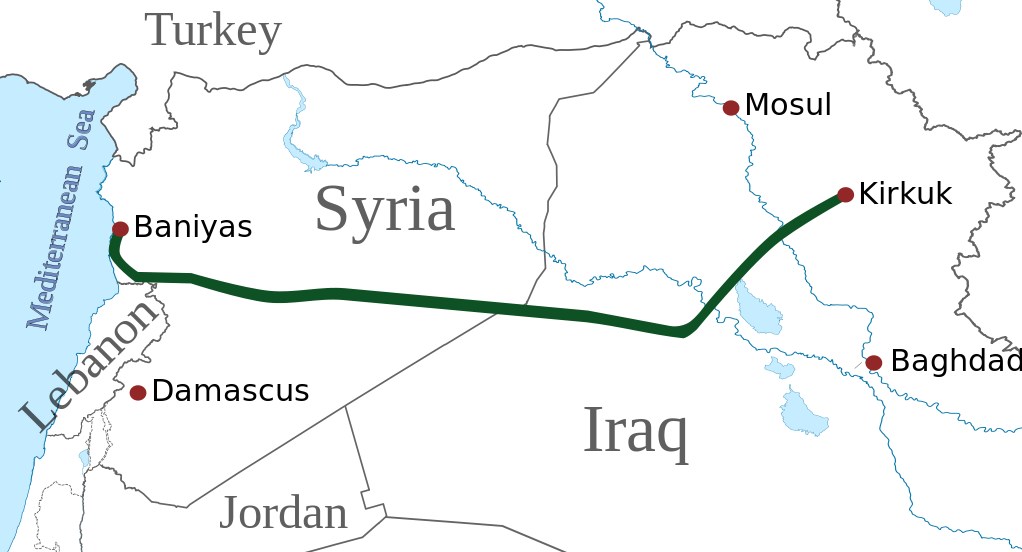Written by Borislav Boev exclusively for SouthFront
The Kirkuk-Baniyas pipeline is a crude oil pipeline, connecting the Iraqi oil field of Kirkuk to the Syrian port city of Baniyas. The pipeline was commissioned in 1952, was 800 km long it had the capacity of transporting up to 300 000 barrels per day.
The pipeline was crucial for the Syrian-Iraqi relations, no matter who had been ruling both countries. It played vital role throughout Saddam Hussein’s last years of ruling Iraq as well.

After the end of the Gulf War, Iraq had been a subject of economic sanctions. The crumbling Iraqi economy was in desperate need of new economic opportunities, generating profits to the country’s dire budget. As we all know, crude oil exports have been main source of income for Iraq’s economy. And it can be no different, after Iraq is the country with second largest proven oil reserves in the world.
The Syrian-Iraqi relations remained stranded for the most of the 90s. Then Syrian president, Hafez Al-Assad (Bashar Assad’s father) had expressed support for the International Coalition led by the USA during the First War in the Gulf. There were attempts to at least warm up the relations between these two neighbors and they found their materialization after Bashar al-Assad came to power in June 2000. Few months later, the Kirkuk-Baniyas pipeline started working again. The exports varied between 150 000 and 200 000 barrels per day. The restart of crude oil exports had allowed Iraq to bypass the imposed sanctions. But it was not only vital for the sanctioned Iraqi economy, it has also played an important role for the Syrians. These exports allowed Damascus to boost its domestic production and thus allowing the Syrian government to increase the exports of their own oil. Increased exports of Syrian oil poured more money into the country’s budged. It was obvious that Syria and Iraq tried to play a “win-win” game. It was a short one, because by then it became obvious that the United States had different plans for Iraq.
The Iraqi side of Kirkuk-Baniyas pipeline was severely damaged after the US war in Iraq in 2003. It was a subject of numerous airstrikes, which had rendered it inoperable since then.
At the end of 2007 when Syria and Iraq had agreed to restore the pipeline. It was about to get reconstructed by the Russian “Stroytransgas” company, a subsidiary of Gazprom. The project ultimately stalled and had never been finished, so the pipeline remained inoperable. The planned rehabilitation would be costlier than building new parallel pipelines, so both governments decided to focus on a brand new project – building two new Kirkuk-Baniyas pipelines. So it’s not about the pipeline itself, it’s about the route.
The ongoing war in Syria has brought destruction to the existing pipeline infrastructure in the country. There are three pumping stations on Syrian territory – T2, T3 and T4. While the T4 was the only one that had remained under government control since the beginning of the war, the other two were in the hands of IS. T3 and the near airport were recently liberated by the Syrian army. Operations on restoring T2 are underway as well. It is currently unknown what are the damages done to the infrastructure, nor what would be repair costs.
The whole Kirkuk-Baniyas pipeline is still a strategic energy installation, although its current state of inoperability. The Syrian government has to do anything in its power to regain control over these areas. They will play a crucial role in post-war Syria and the rebuilding plans. It is currently unknown if the Iraqi government is willing to restore the old route or invest in building a completely new pipeline. Shortly before the outbreak of the war in Syria, Damascus and Baghdad had signed an initial agreement to build two crude oil pipelines on the existing route. It has been quiet since then.
Both governments know that they can’t do it on their own, mainly because they don’t have the budged to do so. Re-opening the Kirkuk-Baniyas route could become a real energy game between all the countries currently engaged in military operations in Iraq and Syria.






Since Saudi Arabia can no longer rely on Turkey to take over Syria, what will they do about their pipeline asperations.
Those are done and they might be seen as a scapegoat by the US/Israel in the future. Their days might not look rosy anymore they make the Plantaganets seem rather dull with their shenanigans.
Israel, as the new gas Qatar, is indeed an interesting country and will give much entertainment and food for thought to the whole region.
Thy could always ask the IMF for a loan.
This is all idle speculation as “both governments”are not in control of neither the whole pipeline nor of, more important, the oilwells.
The oilwells of Kirkuk are under control of the KRG forces and will become part of an independent KRG. So this project only has a change if they start with talking to the KRG, who might be interested as it gives them a third export option.